Flying High? Or Just Trying to Survive?
Cutting Corners: The Shrinking Fleet
Spirit Airlines has announced a bold, if not bizarre, strategy: offloading 23 of its Airbus A320 and A321 planes. The sale aims to help Spirit shore up cash reserves and survive ongoing financial turbulence. A $519 million deal with GA Telesis gives Spirit some breathing room, albeit at the cost of nearly 11% of its fleet.
The soon-to-go planes include the “ceo” (current engine option) models, which boast efficiency but aren’t exactly cutting-edge. Spirit owns 64 A320ceos and 30 A321ceos; losing these aircraft will reduce its fleet to around 189 planes. The transaction, expected to conclude by February 2025, allows Spirit a strategic cash infusion that’s essential for staying in the air.

Staffing Turbulence Ahead
Not only planes but also employees are being grounded. Spirit plans a workforce reduction expected to save the airline $80 million annually by early 2025. Last month, Spirit furloughed 186 pilots, hinting at a troubling future for many of its employees. The decision stems from the carrier’s reduced flight schedule and a need to trim costs drastically.
The airline’s bold cost-saving measures are hardly the endgame. With capacity expected to drop “in the mid-teens” percent, Spirit may yet find itself needing more drastic steps to stay afloat. Spirit’s reliance on furloughs and layoffs shows the extent of its budget-conscious strategies as the airline seeks a path back to profitability.
Debt, Deals, and Debt Again
While Spirit’s plan may seem extreme, it reflects a necessary reaction to financial instability. The budget airline recently managed to delay its debt refinancing deadline, buying it crucial time and avoiding potential bankruptcy—for now. Yet this extension comes with expectations: Spirit must show creditors and investors it’s serious about tightening its belt.
Meanwhile, rumors of a merger linger, perhaps offering Spirit a glimmer of hope. Combining forces with another airline could stabilize Spirit’s operations, but it would also mean more changes for employees and customers. Any merger or acquisition remains speculative, but it’s a card Spirit could play if things get even more turbulent.
Spirit’s Gamble: Will It Fly?
Spirit’s strategy of selling planes and laying off workers might keep the company airborne, but at what cost? With reduced flights, fewer aircraft, and a shrinking workforce, Spirit risks diluting its customer experience. Whether these drastic measures will help Spirit regain its balance or push it closer to a nosedive is anyone’s guess.
For now, Spirit Airlines is betting big on survival and hoping that shedding weight will lift it out of the financial storm.



